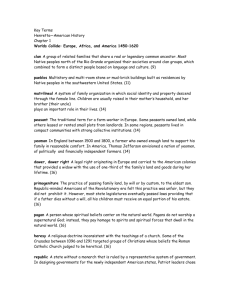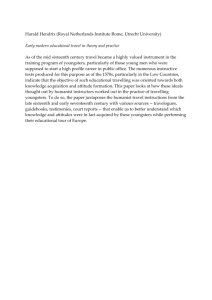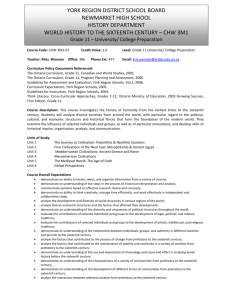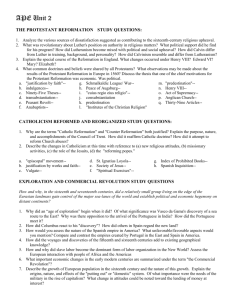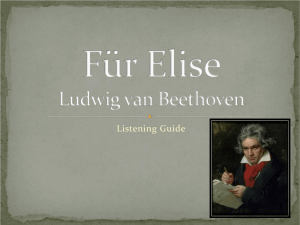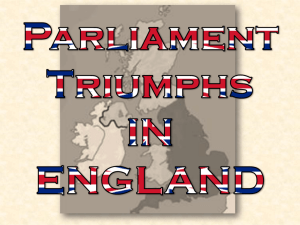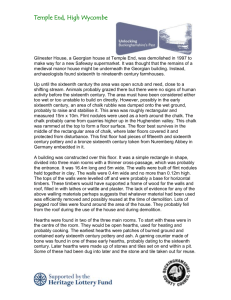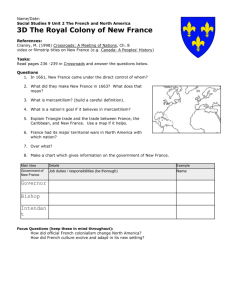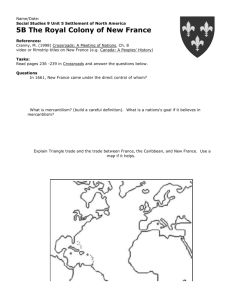Roger E. Backhouse: The Ordinary Business of Life Chapter 3 THE
advertisement
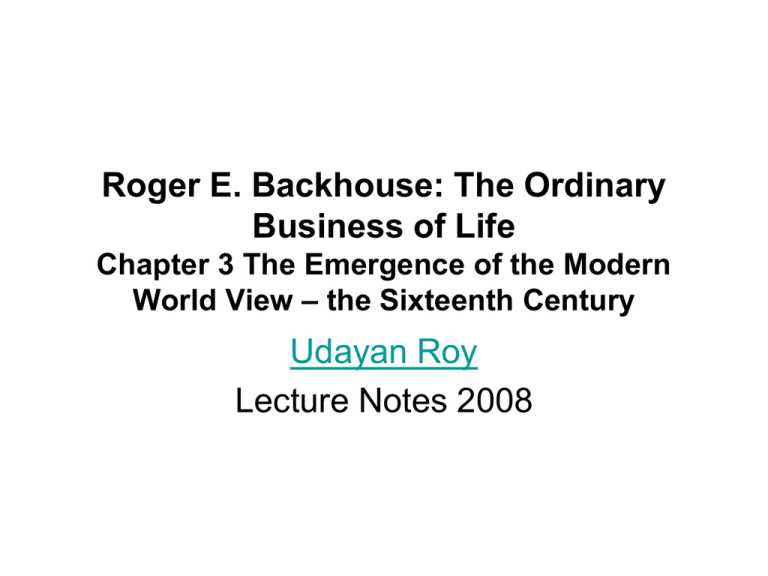
Roger E. Backhouse: The Ordinary Business of Life Chapter 3 The Emergence of the Modern World View – the Sixteenth Century Udayan Roy Lecture Notes 2008 The emergence of the modern world view • • • • • • • • The Renaissance The Reformation The rise of the European nation state Mercantilism Machiavelli The School of Salamanca England under the Tudors Conclusions THE SIXTEENTH CENTURY 2 The Renaissance • The end of the 15th century marks the beginning of the modern world view – The Great Voyages of Discovery • Columbus reaches the Americas in 1492 • Vasco da Gama explores the African coast and reaches India in 1498 • The results are: expanded trade and broader view of humanity – Rediscovery of Greek and Latin classics. Huge explosion in the creative arts, especially in Italy, and in science, especially in astronomy • Discovery of the physical laws of gravity that explained the movements of planets as well as simple objects led to speculation about general laws that determine social and economic life THE SIXTEENTH CENTURY 3 The Reformation • Publication of Martin Luther’s 95 theses in 1517 – Impact accelerated by • the invention and spread of movable-type printing • The rise of nation states • Effect on economic thinking was minimal • Greater impact on political thought – Natural Law, rather than papal authority, became the basis for political legitimacy THE SIXTEENTH CENTURY 4 The rise of nation states • England, France, Spain, and Portugal • Attention focused on how national power could be enhanced – To protect access to new trade routes that developed as a result of the Spanish and Portuguese geographical discoveries – To do the work that had hitherto been done by the Catholic church • Introduction of the Poor Laws in England by Elizabeth I in 1597 – 1601 – Emergence of a new school of economic thought, Mercantilism THE SIXTEENTH CENTURY 5 Mercantilism (1500-1776) • This school of economic thought arose in England during the 16th through the 18th centuries, and then spread to France, Holland, and other countries. • Many of the contributors to this literature were merchants or members of the mercantile class, hence the name. THE SIXTEENTH CENTURY 6 Mercantilism—main themes • The main themes of Mercantilism are as follows: – The ultimate objective of economic policy is the political power, both internal and external, of the state. – The power gained by one state means power lost by another state. • Therefore, the interests of nation states are perpetually in conflict. – A nation’s power is measured by its population and its stock of precious metals such as the gold and silver that are embodied in the money in use at the time. • A high population could supply soldiers. • Money (in the government’s treasury) could pay for large armies and navies. – Continued on next slide THE SIXTEENTH CENTURY 7 Mercantilism—main themes • The main themes of Mercantilism are as follows: – Continued from last slide – Population growth and a rich treasury could only come from prosperous industry and trade. – This prosperity could be brought about if the economy’s stock of money (i.e., gold and silver coins) is large. – Assuming a state does not have gold and silver mines, the only way it would increase its stock of those metals is if it exports more than it imports. As a result, ensuring a trade surplus for oneself and a trade deficit for one’s rivals is the primary objective of economic policy. – Tariffs and other import restrictions can be effective in reducing imports. Subsidies and regulation can be effective in increasing exports. THE SIXTEENTH CENTURY 8 Mercantilism—the lasting contributions • All this was pretty illogical stuff and the mercantilist literature lost its luster as soon as the Classical school emerged in the 18th century. • However, even the casual thinking of the mercantilists made some lasting contributions. • The mercantilists understood that an increase in the quantity of money increased output and employment, while a decrease in the quantity of money decreased output and employment. – This idea is now widely accepted except that the effect of money on output and employment is now seen as temporary, a point that the mercantilists were not clear on. THE SIXTEENTH CENTURY 9 Mercantilism—the lasting contributions • In 1588 Giovanni Botero published a theory of population that was essentially the same as the theory of population for which the Classical economist Thomas Malthus gained fame. Population tends to grow without limit. Food, however, is limited. Therefore, population growth would ultimately be slowed by celibacy or through war, famine and epidemics. • Also in 1588, Bernardo Davanzati stated that people work in order to be happy and not for some other motive, a form of the principle of utility maximization. – Marginalist economists would later develop the idea into a full-fledged theory of demand. • In 1696 Gregory King discussed the now widely used concept of the price elasticity of demand and even used data on prices and sales of wheat to calculate an estimate of the price elasticity of wheat. THE SIXTEENTH CENTURY 10 Mercantilism—the lasting contributions • Building on the commonplace idea that countries trade because not all countries can grow everything, mercantilists built a theory of international trade that came close to a statement of the principle of comparative advantage for which the classical economist David Ricardo is famous. – In 1663, Samuel Fortrey explained that we should produce and export what foreigners want if that would allow us to import more of what we need than we could produce at home. THE SIXTEENTH CENTURY 11 Mercantilism—the lasting contributions • Pierre le Pesant, Seigneur de Boisguilbert (16461714) made two important points. – First, he pointed out that taxes reduce the productivity of the economy and that more tax revenues for the government did not necessarily mean less after-tax income for taxpayers. If the tax system is designed in a way that takes care to reduce the negative effects of taxes on productivity, the government could earn more tax revenues without reducing the after-tax incomes of the citizens. This idea is nowadays championed by a group of economists called supply-siders. – Second, Boisguilbert also said that left to itself the economy settles down to a stable outcome instead of becoming chaotic. THE SIXTEENTH CENTURY 12 Mercantilism—assessment • While the main ideas of the mercantilists caused a lot of harm and are now discredited, the economists of that period came up with many ideas that lasted and created the foundation of the Classical school. • The problem was that the good ideas of the mercantilists had not yet won the debate, which is why they simply coexisted with all the other bad ideas. • As the classical era progressed, the good ideas of the mercantilists were filtered out, recognized as good ideas and incorporated into the classical canon. THE SIXTEENTH CENTURY 13 Niccolo Machiavelli (1469 – 1527) • The Prince, 1513 • The interests of the state were seen as unrelated to religion • A distinction was drawn between the science of how politics works and the ethics of how it ought to work • Both inductive and deductive analysis were used • It was assumed that people would behave unscrupulously, in a self-interested manner – Machiavelli understood that in some cases men may behave morally, but felt that his analysis would make better predictions if self-interested behavior was assumed – This has become the standard assumption in economic analysis THE SIXTEENTH CENTURY 14 The School of Salamanca • These writers in Spain continued developing the ideas of the scholastics and made innovations in monetary economics THE SIXTEENTH CENTURY 15 The School of Salamanca– Navarrus (1491 – 1586) • As in the case of any other trade, moneychanging was okay as long as it earned moderate wealth for the changer • The price of a currency depended on availability, need, uncertainty about the possibility of debasement or even repudiation • It was okay for a money changer to buy a currency when it is cheap and to sell it when it is expensive THE SIXTEENTH CENTURY 16 The School of Salamanca– Navarrus (1491 – 1586) • He provided a unified theory of supply and demand to explain the prices of all commodities, including money – ‘all merchandise becomes dearer when it is in great demand and short supply, and that money … is merchandise and therefore becomes dearer when it is in great demand and short supply.’ • This theory was used to explain the inflation in Spain after the inflow of gold and silver from its American colonies • Navarrus and Jean Bodin (1530 – 1596) provide the first statements of the crucial idea that increases in the quantity of money lead to higher prices THE SIXTEENTH CENTURY 17 The School of Salamanca–money • Thomas de Mercado (? – 1585) explained why the gold and silver in Spain eventually leaked out to other countries – The inflow of gold and silver from the American colonies led to higher prices in Spain. – So, the Spanish people used the gold and silver to buy foreign goods. – This outflow would continue till prices were equal in Spain and elsewhere – Laws prohibiting the export of metals would fail • The idea that scarcity makes goods expensive (and plenty makes them cheap) was known in ancient times • Therefore, it is not surprising that Jean Bodin (1530 – 96), a French economist, also detected the link between the availability of precious metals and inflation. THE SIXTEENTH CENTURY 18 England under the Tudors • Sir Thomas Smith (1513 – 77) – Explained the distinction between nominal and real (inflation-adjusted) income • especially the fact that people on fixed income are affected by inflation, but not traders – Noted that prices were rising even when goods were plentiful and assigned currency debasement as the reason for rising prices • This highlights the idea that the supply and demand for goods affects their relative prices, whereas the supply and demand for money affects nominal prices – Smith was a mercantilist in his views on trade policy – But he had a clear understanding of how markets worked and how prices were determined THE SIXTEENTH CENTURY 19 Conclusions • Lawyers, officials, and other non-priests were beginning to write on economic issues • As a result, the focus shifted from moral issues to how economies actually worked • Besides, the economies were becoming more complex entities • These factors led to progress in economic thought THE SIXTEENTH CENTURY 20
